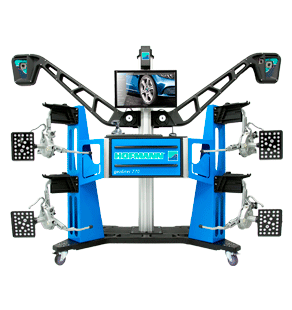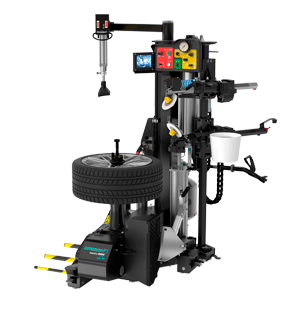Wheel Alignment: A Complete Guide
Wheel alignment plays a big role in how your vehicle handles, how your tires wear, and how safe it feels on the road. Even small misalignments can affect steering, reduce tire life, and make driving less stable, especially in rough weather or at higher speeds.
This guide explains the essentials of wheel alignment. You’ll learn about the three key angles, camber, toe, and caster, and why staying on top of them helps you drive more smoothly, avoid extra costs, and keep your car in top shape.
What is Wheel Alignment?
Wheel alignment is the process of adjusting your car's wheels so they sit at just the right angles: straight, level, and working in sync. When alignment is off, you'll feel it through uneven tire wear, drifting steering, and a ride that just doesn't feel right.
At its core, alignment ensures each wheel is properly positioned relative to the road and to the other wheels, based on your vehicle's original manufacturer settings. Technicians use high-precision equipment to measure and fine-tune each angle down to fractions of a degree.
Proper alignment isn't just about extending tire life (though it does that, too). It makes your car handle predictably, steer smoothly, and respond exactly when you need it to.
The Importance of Proper Alignment
When your wheels are even slightly misaligned, your vehicle starts working against itself and so do you. You might not notice it at first, but over time, your tires wear unevenly, your fuel economy drops, and your car doesn’t feel quite right on the road.
Here's an in-depth look at potential problems and the benefits of maintaining proper alignment:
Premature Tire Wear: Misalignment causes uneven tire wear patterns that lead to premature tire replacement. This increases maintenance expenses and can also compromise vehicle grip and road safety. Proper alignment ensures even wear distribution, which increases tire lifespan and improves your tire investment value.
Increased Replacement Costs: When tires wear unevenly and prematurely, replacement costs can pile up quickly. Additionally, improper alignment stresses other parts of your vehicle, including suspension and steering systems, potentially leading to additional repairs and associated expenses.
Compromised Vehicle Safety: Poor alignment may cause vehicle pulling, which becomes particularly dangerous in wet or icy conditions. This pulling reduces your control and contributes to higher risk of accidents.
Reduced Fuel Efficiency: Misaligned wheels create increased rolling resistance, forcing your vehicle's engine to work harder for forward motion and consume more fuel. Proper alignment maintains better fuel efficiency, which also reduces environmental impact.
The Three Key Alignment Angles
Camber
The inward or outward tilt of the tire when viewed from the front. Slight negative camber (inward tilt) improves cornering, but excessive camber causes rapid inside edge wear.
Toe
The direction tires point when viewed from above. Incorrect toe causes wandering on straight roads and creates sawtooth wear patterns.
Caster
The forward or backward tilt of the steering axis from the side view. Positive caster improves stability and steering feel, though it doesn't directly affect tire wear.
The Alignment Process
Getting your wheels properly aligned isn’t guesswork. It’s a precise process built on accurate measurements, smart technology, and trained technicians. During professional wheel alignment service, mechanics use state-of-the-art equipment for exact measurements. Hofmann wheel alignment machines, renowned for their innovative features including advanced imaging technology and precision sensors, play a key role in these settings.
Initial Inspection
The alignment process begins with a comprehensive inspection of the vehicle's suspension system and current alignment status. Technicians examine all signs of wear or damage that could affect alignment, including worn steering components or damaged tires. This step is vital for identifying underlying issues requiring attention before alignment corrections can be effectively performed.
Angle Adjustments
Using specialized Hofmann alignment equipment, trained technicians adjust tire angles with exceptional precision. These adjustments modify camber (tire angle inward or outward), toe (tire direction relative to each other), and caster (steering pivot angle from the side view). Each setting plays a critical role in vehicle handling characteristics and tire wear patterns.
Verification
Once adjustments are completed, technicians use advanced Hofmann alignment machines to verify all settings meet vehicle manufacturer specifications. This step ensures adjustment accuracy and confirms each wheel aligns correctly relative to the vehicle's centerline, utilizing features like automatic height tracking and smart notification systems for enhanced precision.
Road Test
The final alignment process step involves a comprehensive road test. This allows technicians to confirm proper vehicle handling and verify that alignment has restored optimal performance levels. Any unusual handling or steering behaviors noted during testing may require additional fine-tuning adjustments.
Signs That Your Car Needs a Wheel Alignment
Staying alert to wheel misalignment signs can prevent further complications and ensure optimal vehicle performance. Below are common symptoms to monitor:
-
Vehicle pulls to one side while driving straight
-
Uneven tire wear - check by running your hand across the tread
-
Off-center steering wheel when driving straight
-
Steering wheel vibration, especially at highway speed
When to Schedule a Wheel Alignment
Alignment isn’t something most drivers think about until a tire wears unevenly or the steering feels off. But by then, damage might already be done. The good news is that with the right timing, you can catch misalignment early and avoid bigger problems down the road.
Here’s when you should book an alignment:
-
Every 6-12 months or 6,000-12,000 miles
-
After hitting potholes or curbs - even minor impacts can affect alignment
-
When installing new tires or suspension components
-
Whenever you notice handling changes or steering issues
Conclusion
Wheel alignment is essential for keeping your vehicle safe, smooth, and efficient. Regular checks help prevent early tire wear, improve fuel economy, and give you better control behind the wheel. It's more than just adjusting angles, it’s a simple way to make sure your car drives the way it’s meant to.
If you skip alignment, you could face higher repair costs and unsafe driving conditions down the road. But staying on top of it helps you get the most out of your tires and keeps your car performing reliably.
As you schedule regular alignments, it’s worth paying attention to the tools behind the service. Shops that use advanced systems, like our precision wheel alignment machines, are equipped to deliver fast, accurate results. Models like the geoliner® 770, with mobile imaging technology, and the geoliner® 678, with smart notifications, help technicians make precise adjustments efficiently. It’s a difference you can feel every time you drive.
Frequently Asked Questions
What is the cost of an alignment?
Wheel alignment costs vary depending on several factors, including alignment type (front-end vs. four-wheel), service provider location, and additional services or packages offered. On average, expect to pay between $50 to $100 for front-end alignment, and $100 to $200 for four-wheel alignment.
How long does an alignment take?
Typical wheel alignment takes approximately one hour. This can vary based on vehicle condition and whether additional adjustments are necessary.
How frequently should you get an alignment?
Generally, wheel alignment is recommended annually or every 12,000 miles, whichever comes first. However, if you frequently drive on rough roads or notice any alignment issue symptoms, you may need more frequent checks.
Is wheel alignment necessary?
Yes, regular wheel alignment is necessary to ensure vehicle safety, efficiency, and tire longevity. Misalignment leads to uneven tire wear, poor handling, and increased fuel consumption.
How fast will tires wear out with bad alignment?
With poor alignment, tires can wear much faster than normal. Severe misalignment can cause uneven tire wear within a few thousand miles, significantly reducing their lifespan.
Do I need a two-wheel or four-wheel alignment?
The alignment type you need depends on your vehicle. Most modern cars require four-wheel alignment due to all-wheel-drive systems or independent rear suspensions. Older or rear-wheel-drive vehicles with solid rear axles might only need two-wheel alignment. It's best to consult with a professional technician to determine the appropriate service for your specific vehicle.
How long should the alignment last?
Proper alignment should last at least one year or until the next tire set is needed, assuming no severe impacts or suspension damage occurs. Regular checks help ensure alignment remains optimal.
What happens if I don't get my wheels aligned?
Neglecting wheel alignment leads to accelerated tire wear, decreased fuel efficiency, and potentially unsafe driving conditions. It can also create additional strain on car components, leading to more expensive repairs.
How Alignment Services Increase Customer Retention for Tire Shops
The ROI of 3D Wheel Alignment Systems
Hands-On Innovation: How EZ-Toe™ Simplifies Toe Adjustments
How to Choose the Best Tire Machine for Your Shop
Symmetric vs Asymmetric Lift: The Key Differences Every Shop Should Know
How to Use a Tire Machine: A Step-by-Step Guide for Safe Operation


 Wheel Aligners
Wheel Aligners
 Wheel Balancers
Wheel Balancers
 Tire Changers
Tire Changers
 Lifts
Lifts



